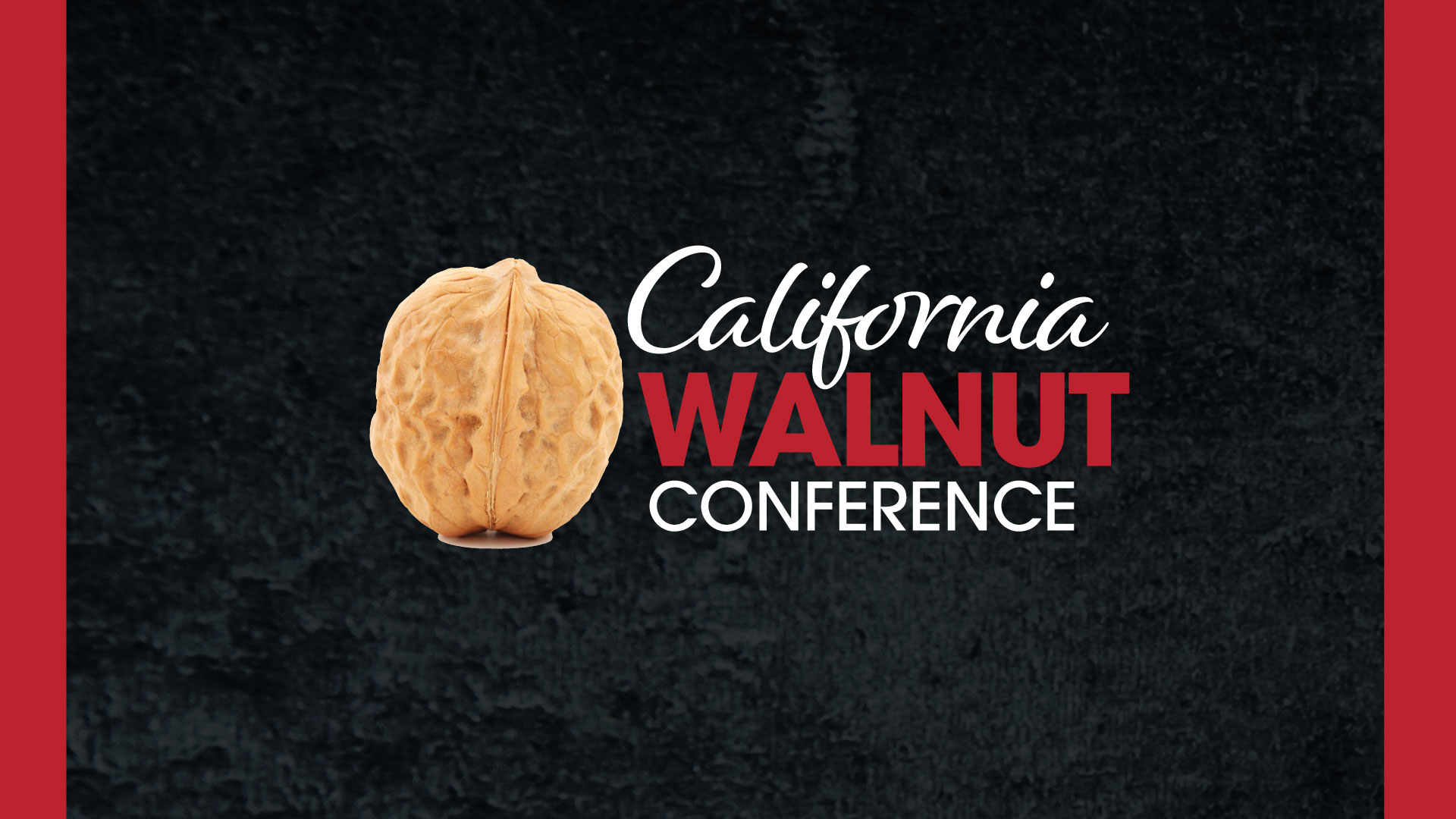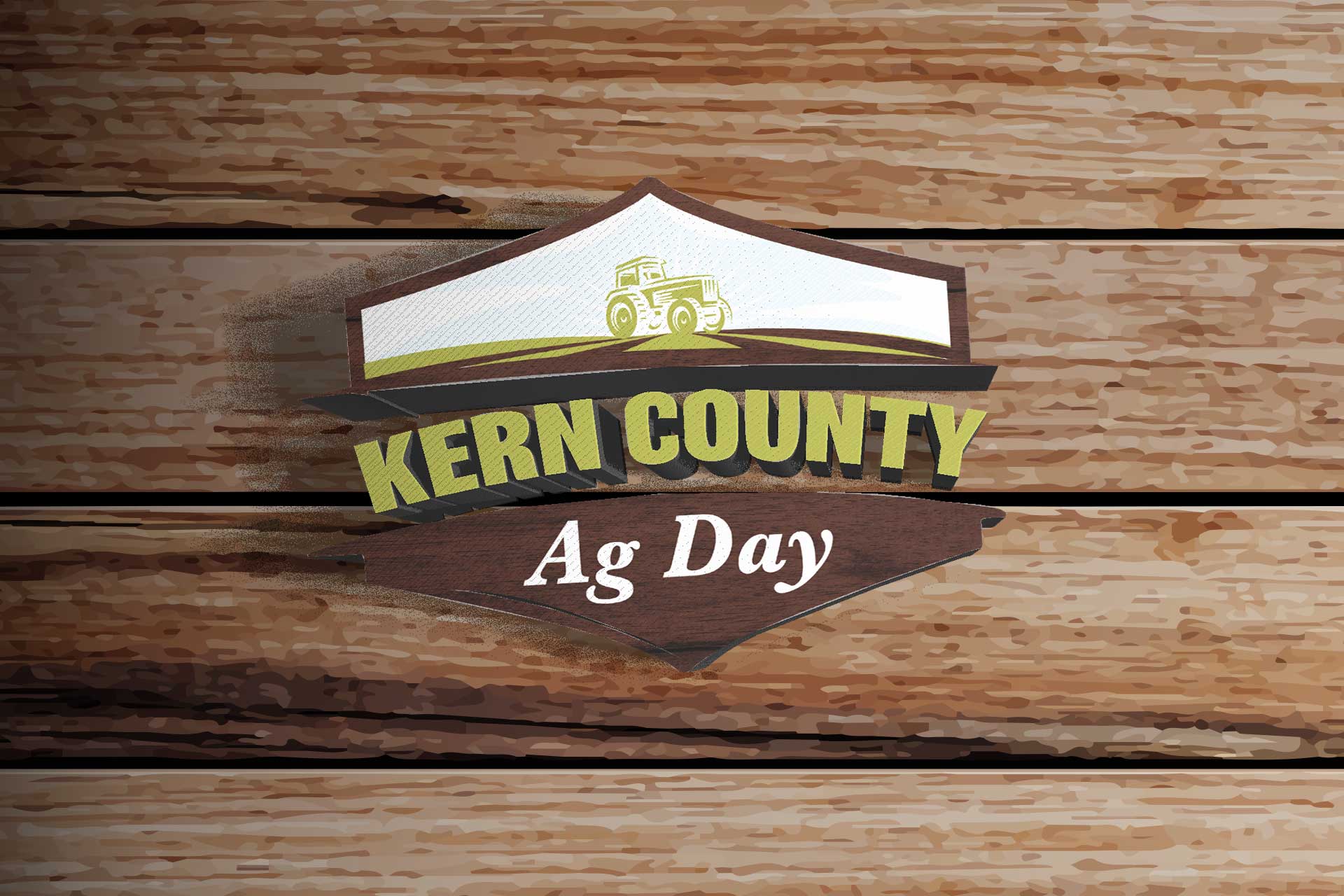Telly Wirth, of Tangent, in Oregon’s Willamette Valley, has this take on fertilizing hazelnuts: With each grower, each orchard, each season and each year, the needs will vary.
Moving to Hazelnut Production
The Wirth family’s operation was originally a grass seed and grain farm, with some acreage planted in legumes and vegetable seed. With the bans on traditional field burning to kill pests, and disease spores, came the need for more chemical use—along with greater expense—to protect the grass seed. So, Telly began searching for a more profitable crop. About 10 years ago, hazelnuts entered the picture for the Wirth family.
Telly’s family started farming in the early 1950s in the Crabtree, Oregon area. When his dad, Dennis was two years old, the Wirth family migrated 23 miles southwest to Shedd, where Dennis started out farming with his brother, Don. The brothers eventually separated their operations, passing down the management of their individual family farms. Telly now farms a total of 2,500 acres, mostly in the Shedd and Tangent area.
Telly majored in Crop and Soil Science at Oregon State University (OSU). In 1999, he graduated from college and married his college sweetheart, Amorita. Telly now grows approximately 140 acres of hazelnuts. He also grows hazelnut nursery stock in tie-off, or layering beds.
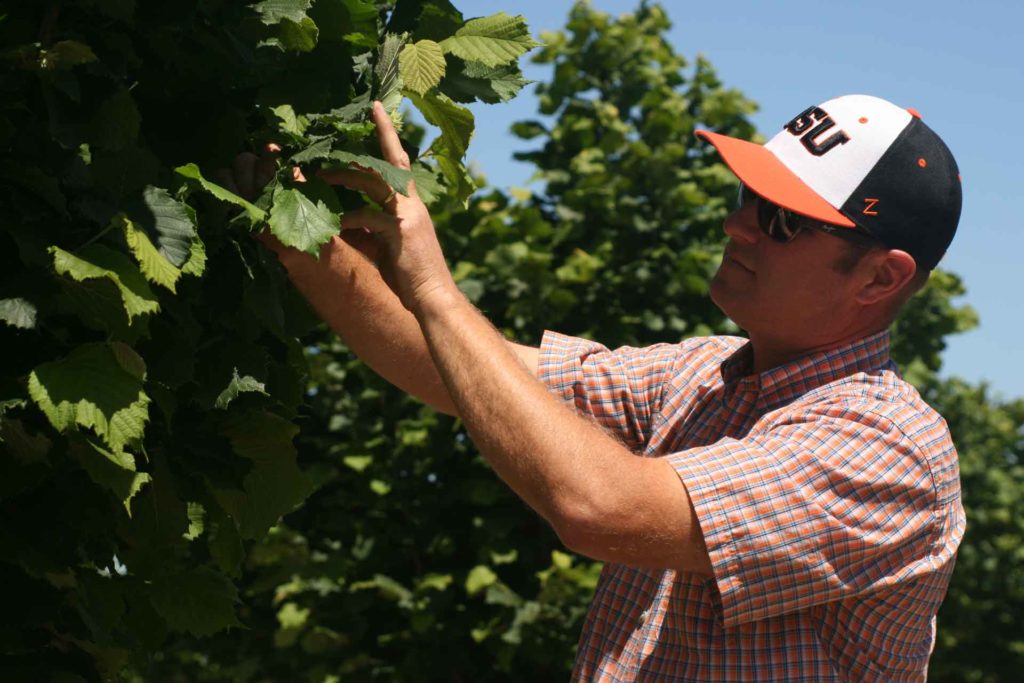
Fertilizer Program
As for Telly’s hazelnut fertilizer program, he starts out each year by taking soil samples in February. “Gives us an idea of what deficiencies to watch out for,” he said. “Hazelnuts like a higher level of potash—some people call it potassium—and phosphorus in valley soils. South of Salem tends to have lower levels of those.” Telly adds that there are pockets of different types of soil all over the valley.
In April to May, prior to active spring growth, Telly gives his non-bearing young hazelnut trees a starter fertilizer—a complete blend of nitrogen, phosphorus and potassium, plus some micro nutrients, which he lays down in a 1-2-foot band. Also in May, his production trees get nitrogen and calcium, which he broadcasts on the entire orchard floor. In June or July, Telly gives one or two light feedings. In July, he starts pulling leaves for tissue samples. When the lab results are back on the samples, he mixes up nutrients his trees need and gives them a foliar spray, along with a spray to control filbert worm.
In November, after harvest, the nitrogen leaches out, Telly said. He might then add phosphorus, potash, magnesium and zinc. “I’m looking to tailor something to get the soil in balance.”
As far as nitrogen, some growers warn to use it sparingly or you will grow weak trees. Telly looks at new growth to tell him if his trees are getting enough nitrogen. He wants to see 12-18-inch whips each year.
When it comes to fertilizing hazelnuts, Telly believes in moderation. “I try to add a little every year, instead of dumping a whole bunch at once. It spreads cost out over time, too.”
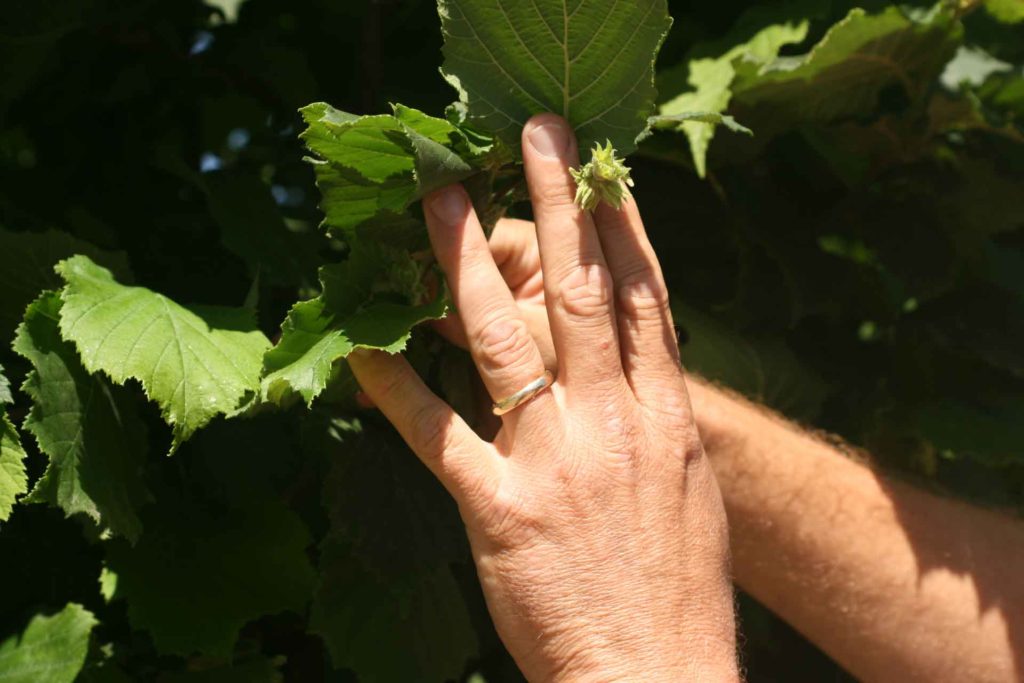
Growing Hazelnuts in Heavy Soil
Dennis Glaser, also of Tangent, was recognized by the Nut Growers Society as the 2019 Hazelnut Grower of the Year. But in 1981, there were some folks who thought the ryegrass farmer was crazy for planting hazelnuts in the heavy soil, flatland area of the valley. Dennis didn’t let other people’s opinions stop him. He went on ahead and planted a Barcelona orchard that year, making him a pioneer in growing hazelnuts in the Mid-Willamette Valley.
“It all started because we were putting (drain) tile in the ground, looking for an alternative crop to grass seed. This is an alternative crop,” Dennis said. Besides, he saw growers in the Newburg area having success with hazelnuts. He figured why not give it a try further south?
Trial and Error Fertilization
How did Dennis go about fertilizing his new valley-floor orchard? It was a brand new world—one of trial and error. No one quite knew how to feed these young hazelnut trees in heavy soil. “I remember my cousins in North Albany putting 100 pounds of Urea on. That’s it,” Dennis said.
Dennis and his son, Ryan, switched to drip irrigation five or six years ago. “Started with hand line,” Dennis said. “It was a pain, but we did it for about 30 years.”
Fertigation Program
Now that Glasers have made the switch, besides laying down bands of nutrients, they’re also able to fertigate through the drip tubes. They start irrigating in mid-July. As far as water and fertigation, Ryan said, “I’m on the trickle theory. I alternate sides of the tree, right or wrong. Theory being I don’t want to concentrate all the roots on one side”
Ryan gives three shots—one each in June, July and August—of a 5-12-5 spray “kicker.” His trees also get a shot of Levitate—which is the brand name of a low-salt starter fertilizer with phosphorus and zinc. Depending on tissue-test results, all of Ryan’s trees—both nonbearing and production—will get a shot of Levitate. “It’s good for structure growth and nuts as well,” Ryan said. “I get pretty good growth throughout the season.”
Sawdust or Compost
Sawdust or compost around trees is helpful in reserving moisture and giving a slow-release feed, but Ryan cautions growers to be careful with compost over the top of drip lines. “Roots can grow over the lines and create a real mess.”
Ryan plans to hire a crop consultant and do pressure bomb tissue tests. A pressure bomb is a portable instrument. It uses pressurized gas to squeeze the moisture from a leaf out the stem. The amount of pressure needed is used to measure the water potential of plant tissue.
Nutrition and Fertigation Trials
Joe Cacka, Hazelnut Research Agronomist with Nutrien Ag Solutions Northwest Division said, “The first growers put potassium chloride at high rates in the spring, instead of fall. Defoliated the trees. Took two years to grow out of it. They gave up on it.”
Joe is currently conducting nutrition and fertigation trials in one of Glaser’s’ younger orchards. He’s laid down a band of fertilizer for three years in a row to get the potassium levels up in the trees. His trials show that 500 pounds of potassium chloride per acre produces a higher yield—400 more pounds of nuts per acre.
Growers have to figure out for themselves if the higher yields balance out the higher fertilizer costs, while still being careful not to get carried away with too much fertilizer. When Joe applied potassium chloride with an extra heavy hand—one ton per acre—the levels built up by about tenfold.
Soils will dry out by the end of June or mid-July, meaning that without irrigation, the least amount of nutrients are available during the nut-filling period, when the trees really need it.
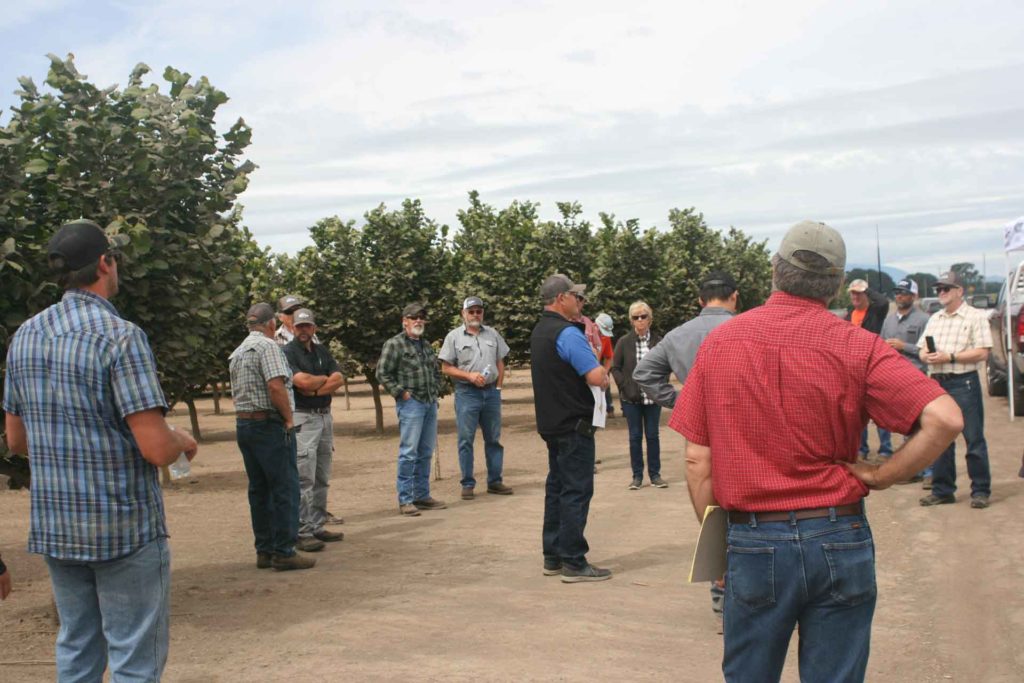
Alternate Bearing and Nutrition
Hazelnut farmers have historically seen alternate bearing years: One year of heavy nut production, followed by a year of lighter crop load. Joe posed the question: “How much does nutrition play a part in that?” Heat stress also affects crop production for the next year. Joe suggests taking a good look at nutrition needs in the fall, especially after a heavy crop. “If the tree isn’t getting enough nutrients from the soil, it will pull it from the bark and roots. I think we can modify it (nutrition), so there isn’t as big a drop from one year to the next.”
A foliar application of calcium, magnesium, boron and zinc “equates to a 20-40 percent yield response in a given season,” Joe said. “Nutrition plays a part in all aspects of growth, including if new nodes become new growth, or bearing branches. Nutrients going into new growth are different than nutrients going into nuts.”
Joe sums it up by saying nutrition needs “really need to be customized to your operation.” He urges growers to take tissue and soil samples and have them lab tested to find out exactly what their needs might be.
Joe also notes that although nutrients need to be pushed down to the tree-root zone, “You don’t want to push down too deep, since eighty-five percent of roots are in the top two-feet of soil.” He added that the sweet spot for nutrients is in the top 1-2 ½-foot zone.
Potassium
“It’s really important to have good levels of potassium in trees,” Joe said.
Potassium levels in leaves often don’t increase until the year after application. Potassium deficient orchards tend to have early leaf fall, which creates more debris in the tote bins. To counter this, growers can use sulfate of potash or potassium chloride—the latter is cheaper.
“Apply potassium in the fall for the least cost. In spring it can damage,” Joe reminds growers.
Joe suggests putting a fertilizer band down one side of the trees one year and switching sides the following year. Flail chopping pruned branches, leaves and husks back into the soil will create a slow-release fertilizer as the organic matter decays.
What does all this information tell hazelnut growers? In a nutshell, that there is always still more to learn.









